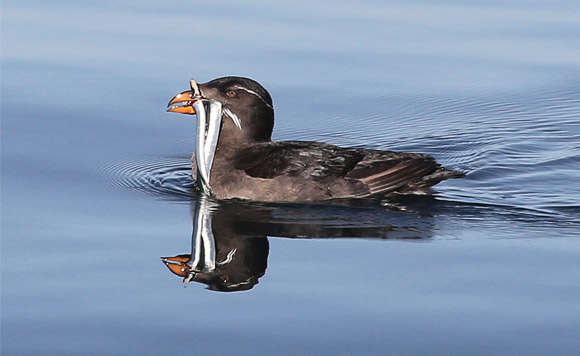by Tina Kelly, Shaw Centre for the Salish Sea –
As a curious kid I peered into my dad’s tackle box to find a school of small, shimmery fish. Not real fish of course, but lures for his early morning fishing trips. Big fish eating little fish is a simple concept to grasp, but the big picture importance of the small fish those lures represent can often be overlooked. The buzz bombs, spinnows, zingers and jigs mimic baitfish; this term certainly describes their application for recreational fishers but scientists prefer to call them forage fish.
Many species of silver schooling fish are categorized as forage fish. Pacific herring, Pacific sand lance, eulachon, surf smelt, sardines, Northern anchovies and others play a critical role in our coastal ecosystem. These small to medium-size fish feed on tiny plankton at the bottom of the food chain and convert that food energy into fat. The resulting rich, fatty nutrients in forage fish are essential to a whole suite of predators. Larger fish, many of which are commercially important – salmon, halibut and lingcod – rely on forage fish. Sand lance alone accounts for up to 50% of the chinook salmon diet and chinook salmon in turn make up 80% of the diet of endangered southern resident killer whales.
Other beloved marine mammals feed on forage fish too. Humpback whales – a species listed as “Special Concern” – engulf large concentrations of schooling fish, notably herring. Porpoises, dolphins, seals and sea lions are others benefitting from the nutrient dense fish. The survival of many marine birds – among them grebes, cormorants, murrelets, murres and rhinoceros auklets – depends on these fish. Some scientists attribute recent declines in several bird species, or shifts in bird migration patterns, to insufficient prey.
Each species of forage fish has specific spawning habitat requirements. For Pacific herring it’s both shoreline substrate and healthy seaweed or eelgrass meadows. For sand lance and surf smelt, a very precise size of sand and gravel is required; the former prefer small sand grains whereas smelt spawn in course gravel. Overhanging vegetation is essential for protecting the eggs from the heat of the sun and insects falling from leaves and branches feed young fish.
Eight million people live in the Salish Sea bioregion and their actions can significantly impact fish populations. Overharvesting and contaminants from run-off and human activities are cause for concern, but human actions along shorelines considerably affect forage fish. Even small development and shoreline modifications can drastically change habitat through time. Seawalls, groynes and other shoreline armoring alter the natural processes of sedimentation and reduce suitable spawning habitat. It’s a simple concept: less spawning habitat results in less fish and a reduction in fish equals less food for a considerable number of species in the food web.
While we are out touting Save the Whales and waving Save our Salmon placards, let’s also consider a Forage Fish Forever bumper sticker. So many species depend on them.
Over 50 species of fish – including forage fish – are on display at the Shaw Centre for the Salish Sea. Photo courtesy Valerie Shore / Eagle Wing Tours.




